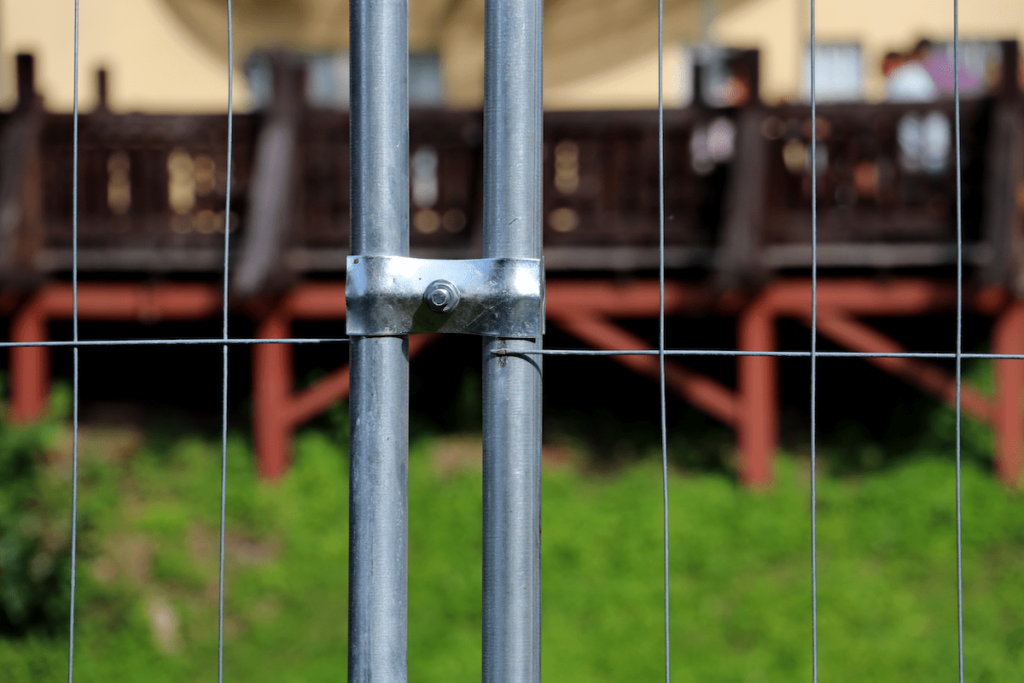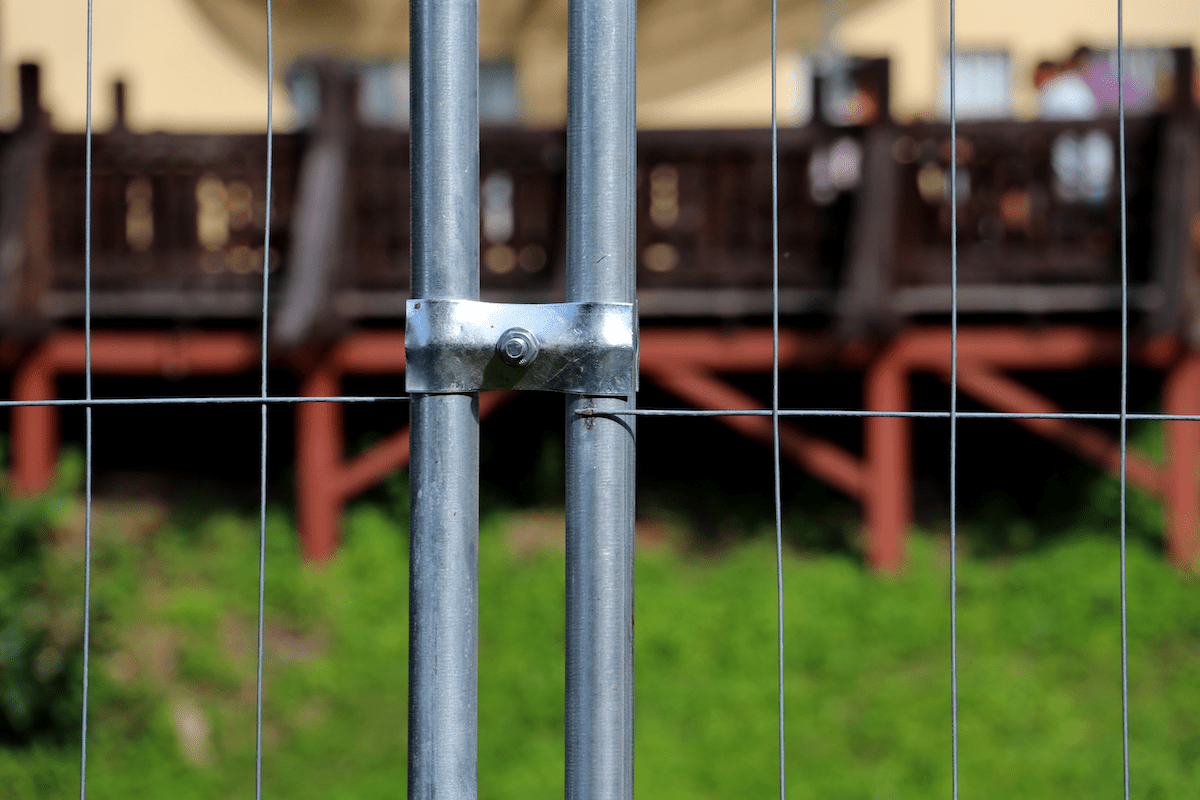Have you ever wondered about the versatility of temporary fencing solutions? Temporary fences can be incredibly useful in a variety of situations, from construction sites and outdoor events to crowd control and private property protection. In this article, we’ll delve into the different types and applications of temporary fencing, exploring their benefits and considerations. By the end, you’ll have a better understanding of how temporary fencing can be a flexible and practical solution for various needs.
Temporary fencing comes in many forms, such as chain-link, plastic, and metal panels. Each type has its own unique advantages depending on the specific purpose it serves. For example, chain-link fencing is commonly used in construction sites, as it provides security and visibility. Plastic fencing, on the other hand, is lightweight and easy to install, making it an ideal choice for temporary events. Metal panel fencing is known for its durability and can be used for long-term applications. In this article, we’ll not only explore the different types of temporary fencing but also discuss their installation process, maintenance requirements, and cost considerations. Whether you’re planning an event, securing a construction site, or looking for temporary fencing for another purpose, this article will provide you with valuable insights and help you make an informed decision.
Now, let’s move on to answering some of the most common questions people have about fences. Here are ten frequently asked questions and their answers:
- What are the benefits of using chain-link fencing?
- Chain-link fencing is durable, cost-effective, and provides high visibility.
- Can chain-link fencing be used for both residential and commercial purposes?
- Yes, chain-link fencing is suitable for both residential and commercial applications.
- How long does it take to install temporary fencing?
- The installation time varies depending on the type and size of the fence, but it can usually be done within a day.
- Are temporary fences easy to dismantle?
- Yes, temporary fences are designed to be easily installed and dismantled, making them convenient for temporary use.
- What are the main considerations when choosing temporary fencing for an event?
- Factors such as crowd control, aesthetics, and ease of installation should be taken into account when selecting temporary fencing for an event.
- Can temporary fencing be customized to meet specific requirements?
- Yes, temporary fencing can often be customized to fit certain needs, such as adding privacy screens or branding.
- Are there any maintenance requirements for temporary fencing?
- Depending on the type of temporary fencing, maintenance requirements may vary. However, regular inspections and repairs are generally recommended.
- Can temporary fencing be used in inclement weather conditions?
- Temporary fencing is designed to withstand various weather conditions. However, certain precautions may need to be taken in extreme weather situations.
- Is it possible to rent temporary fencing instead of purchasing it?
- Yes, many companies offer temporary fencing rental services, which can be a cost-effective option for short-term needs.
- Can temporary fencing be used as a long-term solution?
- While temporary fencing is designed for temporary use, some types, such as metal panel fencing, can be used as a more permanent solution if desired.
Examining the Versatility of Temporary Fencing Solutions
Temporary fencing solutions offer a flexible and adaptable option for various applications. Whether you need to secure a construction site, manage outdoor events, control crowds, maintain pool safety during construction, or create animal enclosures, temporary fences can provide a cost-effective and efficient solution. In this article, we will explore the versatility of temporary fencing solutions, including their benefits, applications, and important considerations.
Types of Temporary Fences
Temporary fences come in different types, each designed to serve specific needs and requirements. Let’s take a closer look at some common types of temporary fences:
Construction Site Fences
Construction site fences are essential for securing and safeguarding construction areas. These temporary fences are typically durable and sturdy to withstand harsh weather conditions and potential accidental impacts. They help prevent unauthorized access, protect workers and equipment, and keep the public safe from potential hazards. Construction site fences are often made of materials like metal or chain-link, providing a robust barrier for increased security.
Outdoor Event Fences
When organizing outdoor events such as festivals, concerts, or sports tournaments, temporary fencing is crucial for crowd control and ensuring safety. Event fences help establish boundaries, guide traffic flow, and prevent unauthorized entry. These fences are often designed with features like panels or barricades that can be easily assembled and disassembled, making them highly portable and convenient for event organizers.
Temporary Crowd Control Fences
Temporary crowd control fences are commonly used at busy locations like airports, train stations, or stadiums to manage pedestrian flow and prevent overcrowding. These fences are lightweight, easy to install and remove, and highly visible to ensure clear separation between different areas. Temporary crowd control fences can be quickly adjusted or expanded to accommodate varying crowd sizes, making them a versatile solution for managing large gatherings.
Pool Safety Fences during Construction
During construction or renovation of swimming pools, it is essential to maintain safety and prevent accidents. Temporary pool safety fences provide a protective barrier to keep unauthorized individuals away from hazardous areas. These fences are typically designed with features like self-closing gates and child-proof locks for added security. They are easy to install and remove, allowing for efficient integration with construction schedules.
Animal Enclosure Fences
Temporary animal enclosure fences are commonly used in situations like pet adoption events, livestock shows, or during construction of animal shelters. These fences are designed to safely contain animals and provide adequate space for their movement. Temporary animal enclosure fences can be customized with features like built-in gates, adjustable panel lengths, and durable materials to withstand potential wear and tear caused by animal activity.
Advantages and Considerations of Temporary Fencing Solutions
Temporary fences offer several advantages over permanent fencing options, but there are also important considerations to keep in mind. Let’s explore these factors:
Quick Installation and Removal
One of the main advantages of temporary fences is their ease of installation and removal. They can be assembled and disassembled relatively quickly, allowing for efficient use in time-sensitive situations. Temporary fences often use modular components, such as panels or posts, which can be easily connected or detached. This flexibility is especially beneficial for events or projects with temporary security needs.
Cost-Effectiveness
Compared to permanent fencing solutions, temporary fences are generally more cost-effective. They require less material and labor for installation, making them a suitable option for short-term or budget-conscious projects. Additionally, their easy removal reduces the need for long-term maintenance or repairs, further contributing to cost savings.
Flexibility and Customization
Temporary fences offer the advantage of flexibility and customization. They can be adjusted to fit specific requirements, such as different sizes and heights, depending on the intended application. Some temporary fences even come with features like adjustable panels or gates, allowing for easy modification to accommodate varying needs.
Portability
Temporary fences are designed to be portable, making them highly versatile for different locations and applications. They can be easily transported and set up in new areas as needed, providing a practical solution for temporary security or containment needs. The portability of temporary fences also minimizes the impact on the environment, as they can be reused multiple times without requiring significant resources.
Limited Long-Term Durability
While temporary fences provide immediate solutions, they may not offer the same level of long-term durability as permanent fences. Temporary fences are often constructed using lighter materials to enhance portability, which may result in reduced resistance to extreme weather conditions or potential damage. Therefore, it is important to consider the expected duration and environmental factors when selecting temporary fencing solutions.
Safety Measures and Compliance
When using temporary fences, it is crucial to ensure compliance with safety regulations and local ordinances. Temporary fences should be installed and maintained according to relevant codes to prevent accidents or legal issues. This includes considerations like fence height, gate accessibility, visibility, and secure anchoring to prevent accidental tipping or displacement.
Maintenance and Repairs
Although temporary fences generally require less maintenance compared to permanent fences, routine inspections and repairs are necessary to ensure their continued effectiveness. Periodic checks for loose panels, damaged components, or signs of wear will help maintain the integrity and safety of the temporary fence. Prompt repairs should be carried out to address any issues that may compromise security or stability.
Aesthetic Considerations
Temporary fences may not always offer the same level of aesthetic appeal as permanent fences, particularly when used in highly visible areas or residential settings. While functionality is often prioritized when selecting temporary fences, it is still possible to find options that blend seamlessly with the surroundings and minimize visual impact. Considering the specific application and intended duration can help strike a balance between functionality and aesthetics.
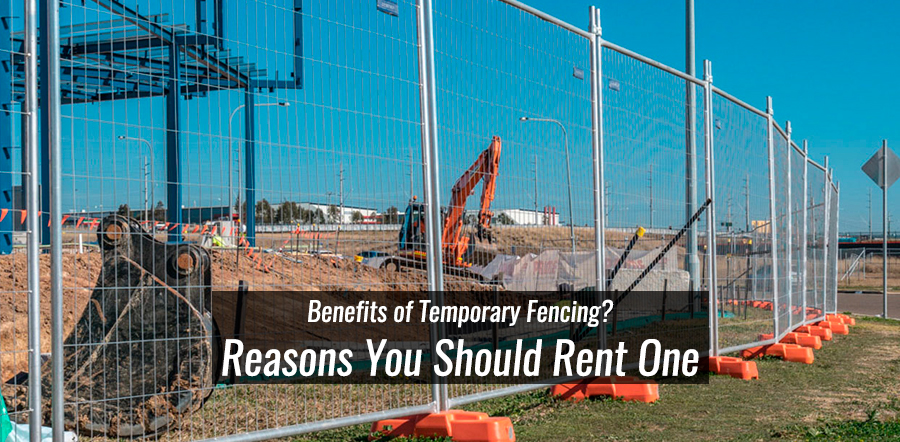
Factors to Consider When Choosing Temporary Fencing Solutions
When selecting temporary fencing solutions, several factors should be taken into account to ensure the most suitable option for your specific needs:
Purpose and Functionality
Identifying the primary purpose of the temporary fence is essential in making an informed decision. Determine if the fence is needed for crowd control, security, animal containment, or some other specific application. Understanding the intended functionality will guide your selection process.
Location and Environment
Consider the location and environmental conditions where the temporary fence will be installed. Is it an open field, urban area, or construction site? Assess factors like wind exposure, ground stability, and potential obstructions. This information will help determine the necessary materials, anchoring methods, and additional features required for the temporary fence.
Duration of Need
Estimate the expected duration for which the temporary fence will be required. Determine if it is a short-term need, such as a one-day event, or a more extended period, such as weeks or months. This information will assist in deciding which fence materials and installation methods are appropriate for the desired duration.
Budget
Consider your budgetary constraints when selecting temporary fencing solutions. Temporary fences come in a range of materials and styles, each with different costs. Determine the maximum amount you are willing to spend and explore options that provide the best value within your budget.
Local Regulations and Permits
Verify any local regulations or permit requirements that may be applicable to the installation of temporary fences. Some areas may have specific height restrictions, installation guidelines, or permit processes. It is crucial to ensure compliance to avoid fines or other legal complications.
Installation and Maintenance
Consider the ease of installation and maintenance required for the chosen temporary fence. Evaluate the available resources (including manpower and time) for installation and ongoing maintenance. Some temporary fences may require professional installation, while others can be easily set up by individuals or small teams.
Security Requirements
Assess the level of security needed for the intended application. Some temporary fences offer additional security features such as lockable gates, anti-climb barriers, or CCTV integration. Determine if these features are essential for your specific needs.
Installation and Maintenance Tips for Temporary Fences
To ensure the optimal performance and safety of your temporary fences, here are some installation and maintenance tips for different types:
Construction Site Fences:
- Ensure proper anchoring of the fence posts to prevent displacement.
- Regularly inspect the fence for loose or damaged components.
- Establish clear signage and warning labels to inform workers and the public of potential hazards.
- Keep the fence clean and clear of debris to maintain visibility and effectiveness.
- Store dismantled fence sections in an organized manner for future use.
Outdoor Event Fences:
- Plan the layout and number of fencing sections needed in advance.
- Clearly mark entrances, exits, and restricted areas with appropriate signage.
- Regularly inspect and repair any damaged or bent panels for consistent security.
- Consider using crowd control accessories such as barricades or ropes to supplement the fences.
- Ensure a smooth flow of foot traffic by creating clear pathways within the event area.
Temporary Crowd Control Fences:
- Connect the fence sections securely to provide a continuous barrier.
- Opt for high-visibility colors to enhance crowd control effectiveness.
- Regularly evaluate the fence placement to maintain optimal flow and safety.
- Implement designated entry and exit points to manage traffic.
- Perform routine checks to ensure the fence is stable and intact.
Pool Safety Fences during Construction:
- Choose self-closing gates with child-proof locks for enhanced safety.
- Regularly assess the fence integrity to ensure it is intact and properly secured.
- Check that the fence height meets local pool safety regulations.
- Remove any potential trip hazards like tools or construction materials within the fenced area.
- Inspect the fence regularly for signs of wear, including loose panels or damaged posts.
Animal Enclosure Fences:
- Select materials that are resistant to animal chewing or scratching.
- Ensure the fence height and spacing between panels are suitable for the specific animals.
- Regularly inspect the fence integrity to prevent potential escapes or injuries.
- Create dedicated entrances or gates for easy access during animal handling.
- Keep the fence clear of debris or vegetation that may compromise containment.
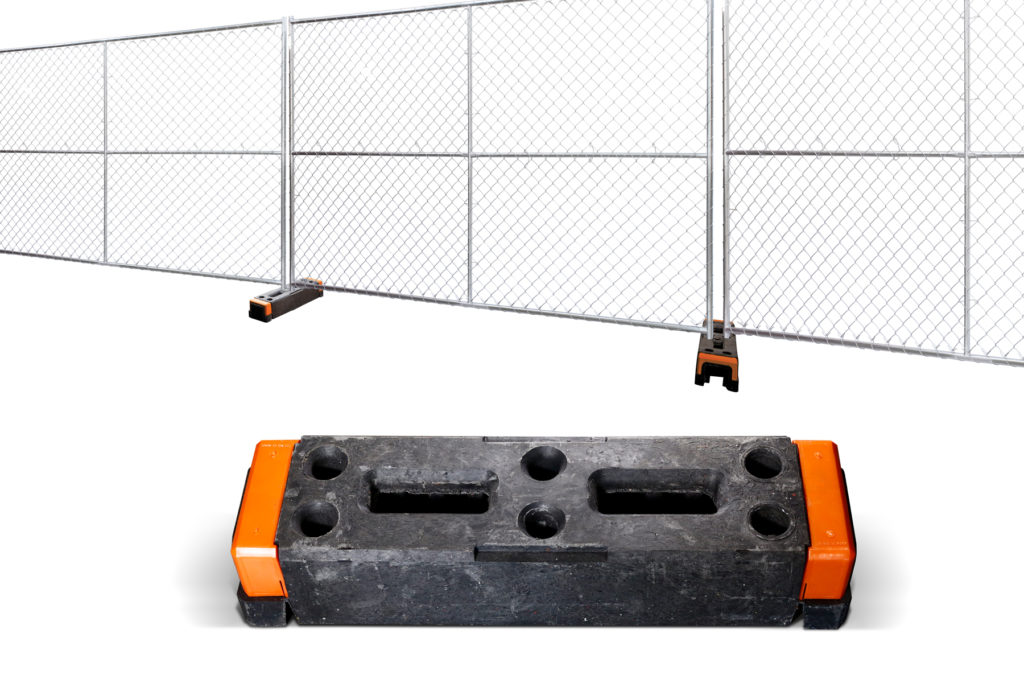
Differences Between Temporary and Permanent Fences
While temporary fences offer several benefits, it is important to differentiate them from permanent fences to understand their specific applications. Here are some key differences:
Legal Regulations
Temporary fences are subject to fewer legal regulations compared to permanent fences. Permanent fences often require permits and adherence to local zoning ordinances. Temporary fences, on the other hand, are typically exempt from such regulations due to their temporary nature.
Height and Design Restrictions
Permanent fences are subject to height limitations and design restrictions in many areas. These limitations are often imposed to maintain consistent aesthetics or adhere to neighborhood guidelines. Temporary fences are more flexible in terms of height and design, allowing for customization based on specific needs.
Purpose and Functionality
Permanent fences are primarily used for long-term security, property boundaries, or enhanced privacy. They are constructed with durable materials and built to withstand years of exposure to the elements. Temporary fences, as the name suggests, are designed for short-term applications where portability and ease of installation are prioritized.
Innovative and Unique Temporary Fence Designs
Temporary fences can also feature innovative and unique designs that go beyond their functional aspects. These designs aim to enhance aesthetics, sustainability, or blend harmoniously with the surroundings. Here are some examples:
Modern Minimalist Fences
Modern minimalist fences are characterized by simplicity, clean lines, and minimal ornamentation. These designs often utilize sleek materials like metal or vinyl, providing a contemporary and sophisticated look. Modern minimalist fences can be easily integrated into various urban or residential settings, adding a touch of elegance to the temporary barrier.
Vertical Gardens as Fencing
Vertical gardens, also known as green walls, are innovative fence designs that simultaneously serve as living plant structures. These fences incorporate vegetation such as vines, herbs, or flowers, turning the temporary barrier into a visually appealing and eco-friendly element. Vertical gardens as fencing not only enhance aesthetics but also provide environmental benefits like improved air quality and insulation.
Artistic and Sculptural Fences
Artistic and sculptural fences turn temporary barriers into eye-catching installations. These fences showcase unique shapes, patterns, or artistic elements, providing a visually striking boundary for temporary applications. Artistic and sculptural fence designs can be tailored to specific events, themes, or locations, creating memorable experiences for both spectators and participants.
Living Fences
Living fences utilize plants or trees to create natural barriers instead of traditional materials. These temporary fences consist of cultivated vegetation, such as hedges or shrubs, which grow over time to form a living and sustainable barrier. Living fences offer environmental benefits, such as improved biodiversity and reduced noise pollution, making them ideal for eco-conscious temporary fencing solutions.
Recycled Material Fences
Recycled material fences repurpose discarded or reclaimed materials to create a sustainable and environmentally friendly alternative. These fences can be constructed using materials like recycled plastic, reclaimed wood, or repurposed metal. Recycled material fences not only provide functional fencing but also promote the principles of sustainability and resource conservation.
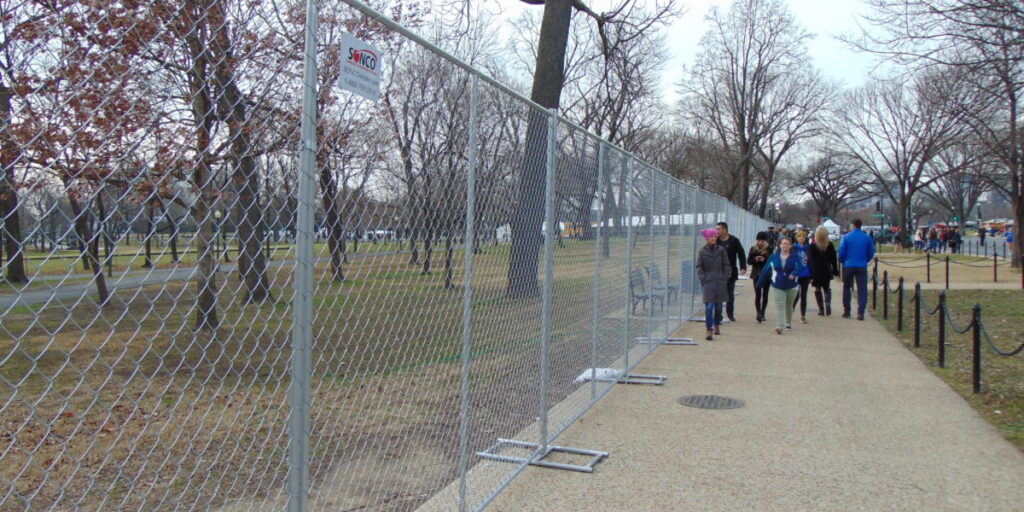
Enhancing Temporary Fence Functionality with Additional Features
In addition to their basic function of providing temporary barriers, fences can be enhanced with additional features to improve overall functionality. These features can add convenience, security, or aesthetic elements to the temporary fence. Here are some examples:
Automatic Gate Systems
Automatic gate systems provide convenient access control for temporary fences. These systems include features like sensors, remote control operation, or keyless entry for authorized personnel. Automatic gate systems can enhance security by ensuring efficient entrance management and minimizing unauthorized access points.
Security Cameras and Alarm Integration
For applications requiring heightened security, integrating security cameras and alarms into temporary fences can be highly beneficial. These additional features provide surveillance capabilities, remote monitoring, and real-time alerts to prevent and respond to security breaches. Security camera and alarm integration can be particularly useful for construction sites, high-profile events, or other sensitive environments.
Solar-Powered Lighting
Temporary fences can benefit from solar-powered lighting systems to enhance visibility and safety. Solar-powered lights can be installed on the fence itself or in the surrounding area, providing illumination during nighttime events, construction work, or in areas with limited ambient lighting. These lights are energy-efficient and environmentally friendly, utilizing the sun’s energy to power the illumination.
Embedded Landscaping
Embedded landscaping involves integrating planters or flower beds into the temporary fence design. These features enhance the aesthetics of the temporary barrier, creating a more visually appealing environment. Embedded landscaping can be used to incorporate natural elements or to match the surrounding landscape, adding a touch of beauty to the temporary fencing.
Decorative Post Caps
Decorative post caps are ornamental features that can be added to the top of temporary fence posts. These caps come in various shapes, styles, and materials, such as metal, wood, or plastic. Decorative post caps can provide a finishing touch to the temporary fence, adding a subtle visual accent and personalizing its appearance.
Temporary Fencing Solutions for Specific Applications
Temporary fencing solutions can be tailored to meet specific needs or requirements. Let’s explore some common applications and the appropriate temporary fence options:
Construction Sites
Construction site fences should prioritize security and safety. Chain-link fences or metal panels are often used due to their durability and high visibility. Consider adding features like privacy screens, debris netting, or pedestrian barriers for added safety and site organization.
Outdoor Events
Outdoor event fences should focus on crowd control and aesthetics. Traditional panel or barricade fences are commonly used, with optional branding or decorative elements. Consider fence systems that can be easily adjusted or expanded to accommodate varying event sizes.
Temporary Crowd Control
Temporary crowd control fences are crucial for managing busy locations. Choose lightweight, highly visible, and easy-to-install fences like plastic barricades or metal crowd control barriers. Consider additional features like reflective tape or signage to enhance visibility and guidance.
Pool Safety during Construction
Temporary pool safety fences during construction should prioritize preventing unauthorized access and protecting individuals from potential hazards. Temporary mesh pool fences, combined with secure gates and self-locking latches, provide an effective barrier. Ensure compliance with local pool safety regulations.
Animal Enclosures
Temporary animal enclosure fences should be secure and provide adequate space. Choose materials that are safe and resistant to animal activity. Chain-link fences with smaller mesh sizes or portable panels are commonly used for temporary animal enclosures.
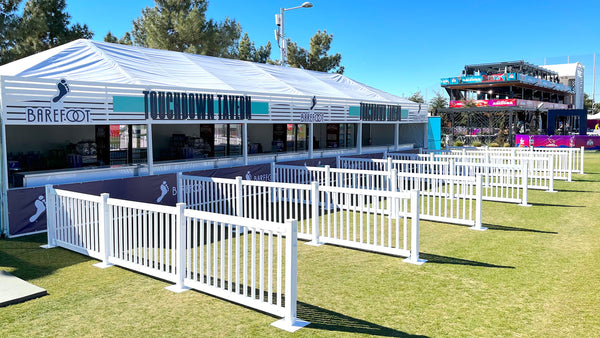
Common Questions About Temporary Fences
To further address common concerns and provide additional information, here are answers to ten frequently asked questions about temporary fences:
-
What is the average lifespan of a temporary fence?
- The lifespan of a temporary fence depends on various factors, such as the materials used, environmental conditions, and the level of maintenance. On average, temporary fences can last from a few months to several years.
-
How can I secure a temporary fence on uneven ground?
- Temporary fences can be secured on uneven ground using options such as ground spikes, sandbags, or weighted bases. These adjustable anchoring methods help ensure stability and prevent shifting.
-
Can temporary fences be painted or customized?
- Yes, temporary fences can be painted or customized according to specific needs or preferences. Some fencing materials may require priming or preparation before painting, so it’s important to follow the manufacturer’s guidelines.
-
Are temporary fences reusable?
- Yes, temporary fences are designed to be reusable. Many temporary fence systems are modular and can be easily disassembled, transported, and reinstalled in different locations.
-
Can temporary fences withstand harsh weather conditions?
- Temporary fences are designed to withstand varying weather conditions, but their durability may vary depending on the materials used. It’s important to select fences made from weather-resistant materials and ensure proper installation.
-
How much does it cost to rent temporary fences?
- The cost of renting temporary fences depends on factors such as the location, fence type, duration, and size of the project. It is best to consult with local temporary fence rental companies for accurate pricing information.
-
Can temporary fences be used for privacy purposes?
- Temporary fences can provide some level of privacy, especially when combined with privacy screens or custom options. However, their primary function is often focused on security and crowd control rather than complete privacy.
-
Do I need a permit to install temporary fences?
- Permit requirements for temporary fences vary depending on local regulations and the specific purpose of the fence. It is advisable to check with the local authorities or relevant organizations to determine if a permit is necessary.
-
Can temporary fences be installed on concrete surfaces?
- Yes, temporary fences can be installed on concrete surfaces. Concrete anchors or specialized clamps can be used to secure the fence posts firmly. It may require additional tools or equipment for drilling or anchoring.
-
Can I install a temporary fence on my own?
- Yes, temporary fences can often be installed by individuals or small teams. However, larger or more complex installations may require professional assistance. It is essential to carefully follow installation instructions and ensure proper safety measures are taken.
Conclusion
Temporary fencing solutions offer a versatile and adaptable option for various applications. From construction sites to outdoor events, temporary fences provide security, crowd control, and safety benefits. By understanding the different types of temporary fences, considering key factors when selecting them, and enhancing their functionality with additional features, you can choose the most suitable temporary fence for your specific needs. With proper installation and maintenance, temporary fences can be effective and reliable solutions, offering peace of mind and flexibility when it comes to securing and managing temporary spaces.
